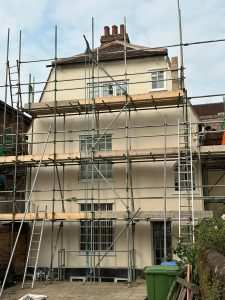Historic building restoration is an intricate and delicate process that demands the utmost care and precision. Preserving the architectural integrity of these structures is essential, as they often embody cultural, historical, and aesthetic significance.
One of the key components in ensuring a successful restoration is the use of scaffolding, which plays a pivotal role in providing access to and protection for these buildings during the restoration process.
Scaffolding is not merely a means to reach higher sections of a building; it is a critical tool that supports the preservation effort. By providing a stable and safe working environment, scaffolding allows craftsmen and conservators to meticulously repair and restore historic structures without compromising their original form.
This blog will explore the essential functions scaffolding serves in historic building restoration, highlighting its role in preserving structure, enhancing safety, ensuring accessibility, and contributing to environmental sustainability.
Preservation of Structure and Detail
One of the primary roles of scaffolding in historic building restoration is to preserve the structure and intricate details of these aged edifices. Many historic buildings have delicate features that require careful handling to avoid damage.
Scaffolding provides the necessary support to maintain the stability of the structure during restoration, allowing workers to access fragile areas without placing undue stress on the building itself.
This is particularly important when dealing with older materials that may not withstand the rigours of modern construction methods.
In addition to providing physical support, scaffolding is crucial for enabling access to the ornate details that often adorn historic buildings.
Intricate carvings, frescoes, and other artistic elements are typically located in hard-to-reach places.
Scaffolding allows restorers to work up close, ensuring that every detail is carefully preserved. For instance, in the restoration of Gothic cathedrals or Victorian facades, custom scaffolding designs are often used to facilitate the meticulous work required to maintain the original artistry.
Enhancing Worker Safety
Restoring historic buildings presents unique safety challenges, particularly when working on uneven or deteriorating surfaces. Scaffolding plays a vital role in mitigating these risks by providing a stable platform for workers.
This stability is essential not only for the safety of the craftsmen but also for the preservation of the building itself. Properly installed scaffolding prevents accidental damage that could occur from falls or the use of unsuitable equipment on delicate structures.
Moreover, compliance with safety regulations is paramount in any construction project, and historic restorations are no exception. Scaffolding systems are designed to meet strict safety standards, ensuring that all work is carried out in a secure environment.
This is particularly important when working at height or on structures that may not be entirely stable due to their age. By enhancing worker safety, scaffolding ensures that restoration projects are completed without incident, safeguarding both the craftsmen and the historic structures they are working to preserve.
Accessibility and Flexibility
The unique architectural features of historic buildings often present challenges in terms of accessibility. Traditional scaffolding may not be suitable for buildings with complex shapes, such as domes, spires, or irregular facades.
However, modern scaffolding solutions are highly adaptable, allowing for custom designs that cater to the specific needs of each project. This flexibility is crucial in ensuring that every part of the building, no matter how difficult to reach, can be accessed safely and efficiently.
In addition to providing access, scaffolding systems can be adjusted or expanded as the restoration progresses. This adaptability is particularly beneficial in long-term projects, where different phases of work may require varying levels of access.
Whether it’s for repairing a roof, cleaning a façade, or restoring internal features, scaffolding can be tailored to meet the evolving demands of the restoration project, ensuring that work can proceed without interruption.
Environmental Considerations
In the context of historic building restoration, environmental considerations are increasingly important. Scaffolding can play a role in minimising the environmental impact of restoration projects. For example, using reusable scaffolding materials reduces waste and supports sustainable construction practices.
Additionally, the careful design and installation of scaffolding can help to protect the surrounding environment, including neighbouring structures and landscapes, from potential damage during the restoration process.
Balancing the use of modern technology with the need to preserve historical authenticity is a delicate task. Scaffolding helps to achieve this balance by allowing restoration work to be carried out without introducing invasive techniques that could compromise the building’s integrity.
By providing a temporary yet robust structure, scaffolding ensures that the restoration process is both environmentally responsible and respectful of the building’s historical significance.
Collaboration with Conservation Experts
Successful historic building restoration requires close collaboration between scaffolding professionals, architects, historians, and conservation experts. Scaffolding must be designed not only to support the physical restoration but also to respect the historical context of the building.
This means that scaffolding structures often need to be unobtrusive and carefully integrated into the restoration plan to avoid overshadowing the building’s original features.
Working alongside conservation experts, scaffolding teams can develop solutions that meet both the practical needs of the restoration and the aesthetic requirements of preserving the building’s character.
For example, in restoring a historic church, scaffolding might be designed to allow ongoing access to the site for visitors or worshippers, ensuring that the building continues to serve its community even as it undergoes restoration.
These collaborations are essential in ensuring that scaffolding contributes positively to the restoration effort, helping to preserve history for future generations.
Conclusion
In conclusion, scaffolding plays an indispensable role in restoring historic buildings, providing the support and access necessary to preserve these irreplaceable structures.
By ensuring the safety of workers, facilitating access to intricate details, and minimising environmental impact, scaffolding enables restoration projects to be carried out effectively and respectfully.
As restoration techniques continue to evolve, the importance of scaffolding will only grow, particularly as more historic buildings are recognised for their cultural value and require preservation.
Through careful planning and collaboration with conservation experts, scaffolding will continue to be a key tool in maintaining and restoring our shared architectural heritage, ensuring that these historic treasures endure for generations to come.




